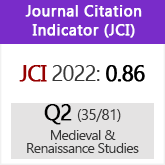La imagen del Miramamolín al Nasir (1199-1213) en las fuentes cristianas del siglo XIII
DOI:
https://doi.org/10.3989/aem.1996.v26.i2.676Abstract
In contemporary Christian sources, the images of the Almohade calif Muhammad al-Nasir, the defeated Miramamolin in great battle of Las Navas de Tolosa (1212), make possible to notice mental and ideological notions shared by the Medieval West of Xlllth Century. For the Europeans, the fear to the powerful Almohade Empire reflected by sources was employed by some chroniclers, with a propagandistic intention, to improve Spanish Crusade or disparage the political and religious enemies of Papacy. For the Spaniards, the al-Nasir's image refered to his role in the campaign of 1212. About the Miramamolin, the chroniclers projected the image of "the other one" supported by the ideology of war in Christian West. Thus, the victorious king's virtues, Alphonse VIII of Castille —faith, humility, courage, loyalty and generosity— opposed to the defeated calif's vices —unbelief, pride, cowardice, disloyalty and covetousness—, generating two opposite models wich purpose was, on the one hand, to exalte the victorious Christians and, on the other hand, to create an explicative recourse of religious and providencial character for, in the chroniclers's mentality, to make sense out of the cause of Muslim desaster in the battle of 1212.
Downloads
Download data is not yet available.
Downloads
Published
1996-12-30
How to Cite
Alvira Cabrer, M. (1996). La imagen del Miramamolín al Nasir (1199-1213) en las fuentes cristianas del siglo XIII. Anuario De Estudios Medievales, 26(2), 1003–1028. https://doi.org/10.3989/aem.1996.v26.i2.676
Issue
Section
Monographies
License
Copyright (c) 1996 Consejo Superior de Investigaciones Científicas (CSIC)

This work is licensed under a Creative Commons Attribution 4.0 International License.
© CSIC. Manuscripts published in both the printed and online versions of this Journal are the property of Consejo Superior de Investigaciones Científicas, and quoting this source is a requirement for any partial or full reproduction.All contents of this electronic edition, except where otherwise noted, are distributed under a “Creative Commons Attribution 4.0 International” (CC BY 4.0) License. You may read here the basic information and the legal text of the license. The indication of the CC BY 4.0 License must be expressly stated in this way when necessary.
Self-archiving in repositories, personal webpages or similar, of any version other than the published by the Editor, is not allowed.














